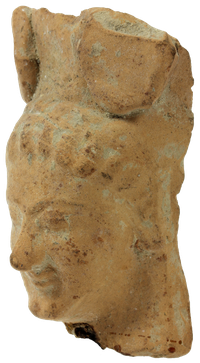Small female head with decorated polos
Description: A polos with disc-like decoration adorns the small head. On the right side of the head is another highly fragmented decorative element. A corresponding element probably also sat in the centre at the front. A thin band wraps around the hair, framing the forehead with an arch of evenly wide strands. Behind the ears - the right one reduced to the indication of the helix, the left one to a protrusion at the level of the earlobe - long strands of hair fall vertically.
The face, which tapers vehemently downwards, has the shape of an equilateral triangle standing on end, accentuated by the large nose and a concise chin. The closed lips are curved upwards in a crescent shape. Shallow indentations beside the corners of the mouth enliven the taut cheeks. Narrow sculpted lids frame the slightly protruding eyeballs. The brows above the low orbits are also plastically indicated.
Commentary: Disc-shaped elements mainly decorate the poloi of female terracotta figurines from the sanctuaries of Metapont[1]. In the case of the Giessen head, however, it could also be a matter of leaf-like decorative elements; this is suggested by the rather rectilinear course of the tattered appliqués up to the break-off edge. As a more completely preserved Metapontine statuette shows, the polos was decorated not only with discs (rosettes) but also with leaves and buds[2].
The face of Inv. no. T I-11 appears bony and pointed. The skin seems to literally tighten around the chin. In this, the small head resembles a statuette from the votive depository "Favale" near Metapont as well as a number of female terracotta heads from other Metapontine shrines[3]. Similarly concise faces with protruding chins are encountered in statuettes from the Siris/Herakleia area[4].
While the ornamentation of the polos is apparently limited to Metapont, stylistic details such as the slightly protruding eyeballs framed by narrow lids, the taut lower face and the pointed chin are also found in archaic female heads from Herakleia and Sybaris[5]. Beyond the coroplastic, Inv. no. T I-11 is also reminiscent of large sculptural works, such as the head of Kore 654 on the Athenian Acropolis[6].
Determination: Second half of the 6th century BC, from Metapont
 |
 |
 |
|---|
[1] Olbrich 1979, 147 cat.-no. A 99 pl. 21; 151 cat.-no. A 106 pl. 24 a. p. 158 cat.-no. A 124 pl. 30; D. Adamesteanu – D. Mertens – F. d’Andria, Metaponto I, NSc Suppl. 29, 1975 (Rom 1980), 184 fig. 195 a.
[2] Olbrich 1979, 150 f. pl. 24 a; pl. 28 b; 157 pl. 29 a.
[3] M. G. Liseno, Metaponto. Il deposito votivo favale (Rom 2004), 38 f. pl. 6 a; Adamesteanu – Mertens – D’ Andria 1980, 264 f. fig. 280; San Biagio, Olbrich 1979, 151 pl. 24 b. 156 pl. 27 e. 157pl. 29 a.
[4] Neutsch 1968, 783 fig. 33 a; S. Bianco – M. Tagliente, Il Museo Nazionale della Siritide di Policoro (Bari 21993) 111 fig. 6.
[5] B. Neutsch, Neue archäologische Entdeckungen in Siris und Herakleia, AA 1968, 782 f. fig. 33 a „Hades (?)“; Bianco – Tagliente 1993, 111 fig. 61; G. Olbrich, Verwandtes und Benachbartes zu den archaischen Terrakotten aus dem Demeter-Heiligtum von Herakleia, in: B. Otto (ed.), Herakleia in Lukanien und das Quellheiligtum der Demeter (Innsbruck 1996), 187 pl. 4, 1; Sybaris: Olbrich ibid. 187 pl. 4, 2. p. 189 pl. 6, 2.
[6] G. Richter, Korai (ND NewYork 1968), 49 no. 654 figs. 212. 213; ibid. p. 73-75 no. 116 fig. 366.

